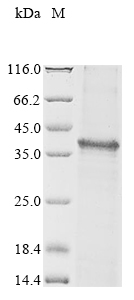Recombinant Mouse Tnmd Protein is encoded by Tnmd gene — recombinant Tnmd DNA — that has integrated foreign plasmids into the Yeast genome, the foreign DNA is replicated along with the host DNA. In addition, the expression of foreign proteins requires the use of specialized expression vectors and often necessitates the significant restructuring of the foreign coding sequence. The subsequent expression process includes small-scale expression, protein identification, large-scale expression, and protein purification. The purity of this recombinant Tnmd is 85%+.
Tnmd (also known as Chm1l) is a gene encoding a protein named tenomodulin (short name is TeM) or chondromodulin-1-like protein (short name is ChM1L). The protein encoded by this gene, also referred to as tendin or myodulin, was discovered as a gene sharing high similarity with the already known chondromodulin-1 in 2001. It is a type II transmembrane protein characteristically expressed in dense connective tissues, such as tendons and ligaments. Currently, this protein has been reported as a tendon/ligament-specific marker and anti-angiogenic factor with abundant expression in the intervertebral disc (IVD).






